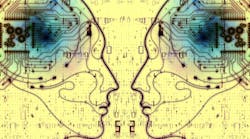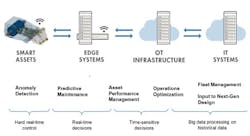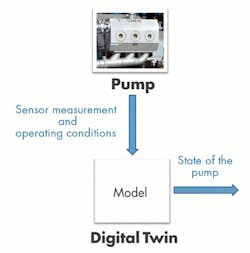Manufacturing, energy and transportation companies are increasingly benefiting from Industry 4.0 applications after years of hype. The emergence of digital twins is one reason engineering and design teams are reaping these benefits for their enterprises.
A digital twin is a real-time digital representation of a real-world operating machine that mirrors that machine’s current condition and provides relevant historical data. Companies can leverage digital twins to analyze real-time performance, improve operations, predict future behavior or refine control of its assets, such as pumps, engines, power plants, manufacturing lines and fleet of vehicles. Engineering teams can use digital twins in several ways to deliver value to their companies and improve operations.
Digital twins capture a physical asset’s history and are updated periodically to also represent the real asset’s current state. Over time, these past states become the asset’s history. Information included in this history differs based on how the twin is used and what’s captured in the current state.
For example, a twin used for fault classification might capture a history that includes a specific pump’s operational data during healthy and faulty states. In the future, engineers can compare operational data from that pump to digital twin histories of other pumps to understand how they behaved under similar faults.
The ability to monitor a whole fleet of vehicles or a factory full of machines using digital twins helps in planning operational events and improving maintenance strategies.
For instance, when a specific truck pump nears failure, the digital twins can assess how this will affect the fleet’s efficiency and what it might cost to fix it. This helps management decide whether to order a new pump and wait for it to arrive or pay for an expedited shipment to get the part as soon as possible.
Companies can also use digital twins to simulate future scenarios to see how factors such as weather, number of machines, size or different operating conditions might affect performance. This lets them manage assets and improve operations by tailoring maintenance schedules or flagging expected failures in advance. Digital twins are helpful in a variety of applications, including anomaly detection and improving operations and predictive maintenance.
Anomaly detection. Companies can run twin models and compare their performance to the real machines. Analysis can flag differences (anomalies) between expected and actual behavior which suggests the actual machines are having issues.
The digital twin models run in parallel to the real assets and flags operational behavior that deviates from expected behavior in real-time. For example, am oil company may stream sensor data from offshore oil rigs that operate continuously while a digital-twin model looks for anomalies in the operational behavior to highlight potential equipment damage.
Operations improvement. Companies can apply variables such as weather, fleet size, energy costs or performance factors to trigger hundreds or thousands of simulations to evaluate readiness or necessary adjustments to current system set points. This approach lets managers adjust operations to mitigate risk, reduce cost or increase efficiencies.
Predictive maintenance. In industrial automation and machinery applications, companies can use digital twin models to determine the remaining useful life of components and assemblies and the most opportune time to service or replace equipment.
In a connected system (shown above) a digital twin could be running on the a ”smart” machine, at the edge or on the IT/OT layers, depending on the application’s required response time. For example, predictive maintenance may require that managers make real-time or time-sensitive decisions, so the twin should reside within the asset or at the edge.
A Digital Twin in Action
Here’s an example of a company using a digital twin. The company drills for oil and gas using several pumps at three different sites. Now it wants to use twin for predictive maintenance on the pumps. So, the company’s engineers design a model (the twin) that gets updated with data from sensors on the pumps and the pumps current operating conditions. That digital twin then outputs the current state of the pump, which the company managers analyze to unlock the following benefits:
Reducing downtime. Each pump contains valuable components such as valves, seals and plungers. The twin reduces downtime by predicting failures, which lets technicians check the pumps and repair or replace them before they fail.
Managing inventory. With the twin predicting equipment life, management can better schedule part deliveries to keep inventory at a minimum while still meeting demand.
Equipment management, what-if scenarios and operational planning. The pumps at the three sites may have provide the functions, but each location has its own environmental factors, such as temperature and humidity, that affects how the pumps operate. The digital twins let the company monitor all of the pumps, simulate future scenarios, and compare different plans for increasing efficiency and improving operational planning.
Building a Digital Twin
As companies learn about the benefits digital twins can bring, they will be urging their engineers to develop some for their assembly and packaging equipment. Here are three types of models (twins) design teams must keep in mind.
Physics-based model. If the company wants to simulate future scenarios and monitor how the pumps will behave under those scenarios, it will use a physics-based model. In many ways, physics-based digital twins are the easiest to understand. Engineers can use modeling tools such as CAD drawings, Simscape and other software to build a virtual model of (for example) a pump. The virtual pump model is “assembled” from virtual parts based on the actual specifications of all the real pump’s components such as pistons and valves.
It takes time and expertise to build such models, but many companies that make pumps or other equipment already go through a similar process when designing new machines. It is more difficult for companies that purchase and operate pumps, rather than designing or building them, to build physics-based twins. They simply don’t always have all the needed information.
Data-driven model. Companies trying to streamline optimize maintenance schedules by estimating remaining useful life (RUL) use data-driven models, but the type of the data needed will determine what kind of model is needed. Similarity models of the pump, for example, can be used if the company has complete histories from similar pumps.
If only failure data is available of the pumps, then a survival model can be used. If failure data is just not available, but the safety threshold is known, a degradation model can be used to estimate RUL. In this RUL scenario, the degradation model is constantly updated using several different measurements of pump performance such as pressure, flow and vibration.
Hybrid model: data and physics combined. A hybrid digital twin is built using both data and a physical understanding of the machine. For example, before completing a digital twin of a pump, engineers first have to build a digital twin for the bearings used in it. But the bearings degrade over time due to debris, a loss of lubrication and wear. There’s no easy way to model debris or a lubrication loss.
If there were data from the pump on the pump’s behavior when the bearings had some debris or were poorly lubricated, a model could be built that combines the bearing’s physics with this data. It could then “track or predict” bearing degradation. This approach takes advantage of indirect measurements of a quantity that would be too hard to physically measure.
Design teams need to create a digital twin for every individual machine or component. This means that for each asset at different location, teams must create a twin that has been initialized with the specific asset’s parameters. The total number of twins depends on the application. If teams are modeling a system of subsystems, they may or may not need a twin for each one, depending on the level of precision needed. For example, if the intention is to run failure prediction and fault classification, design teams need to create different models that serve these different purposes.
The team designing the digital twin can take the extra steps to make the finished model easy to use for other engineers and plant personnel. For example, if the team took the pains to build a dashboard or a point-and-click tablet that let users intuitively interact with the digital twin, ramp-up times for using and getting the most from the twin would be significantly shortened.
The flexibility and various potential benefits of digital twins makes them a top priority for companies transitioning to Industry 4.0. Having an up-to-date representation of real operating assets lets engineering and design teams unlock insights in data to improve efficiencies, automate and evaluate future performance, all of which should reduce costs and shorten development timelines.
Aditya Baru is a senior product marketing manager at MathWorks.


